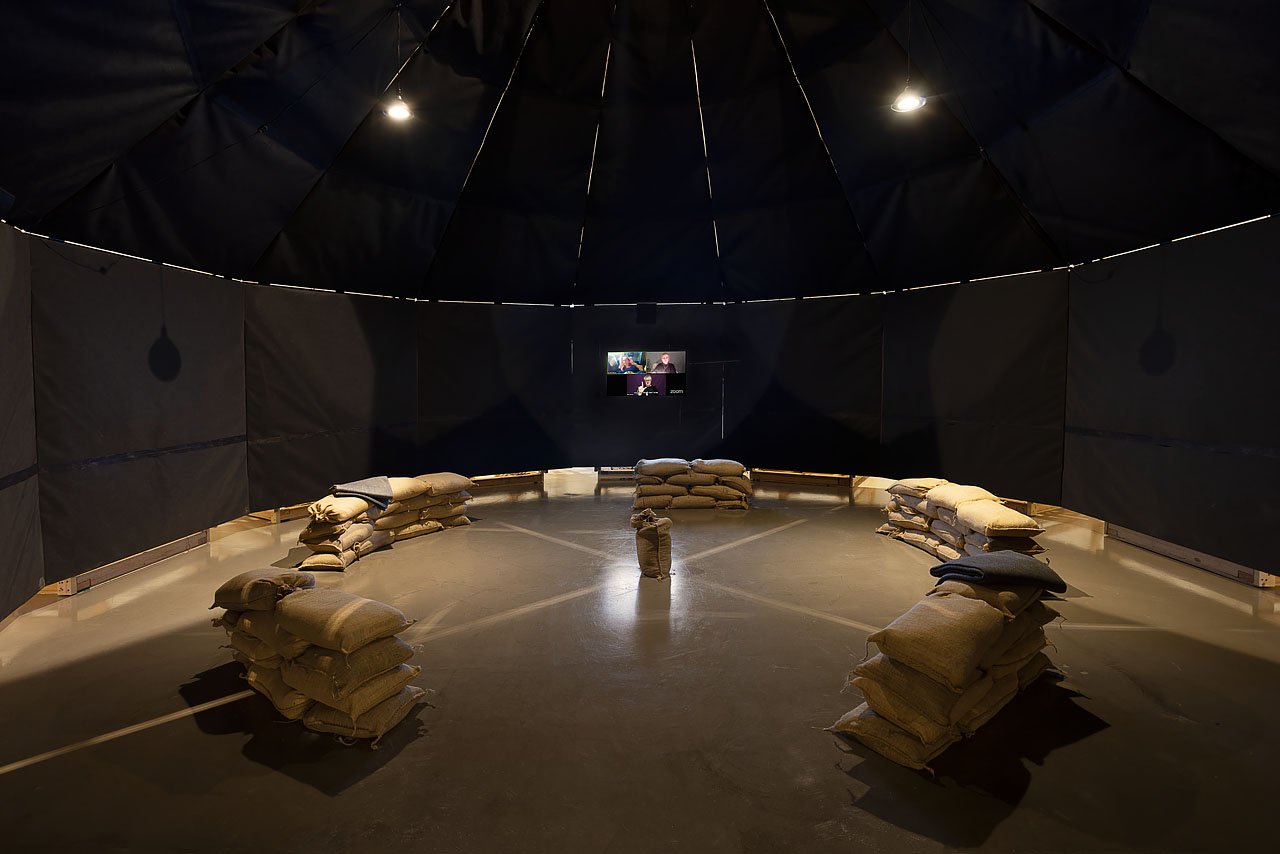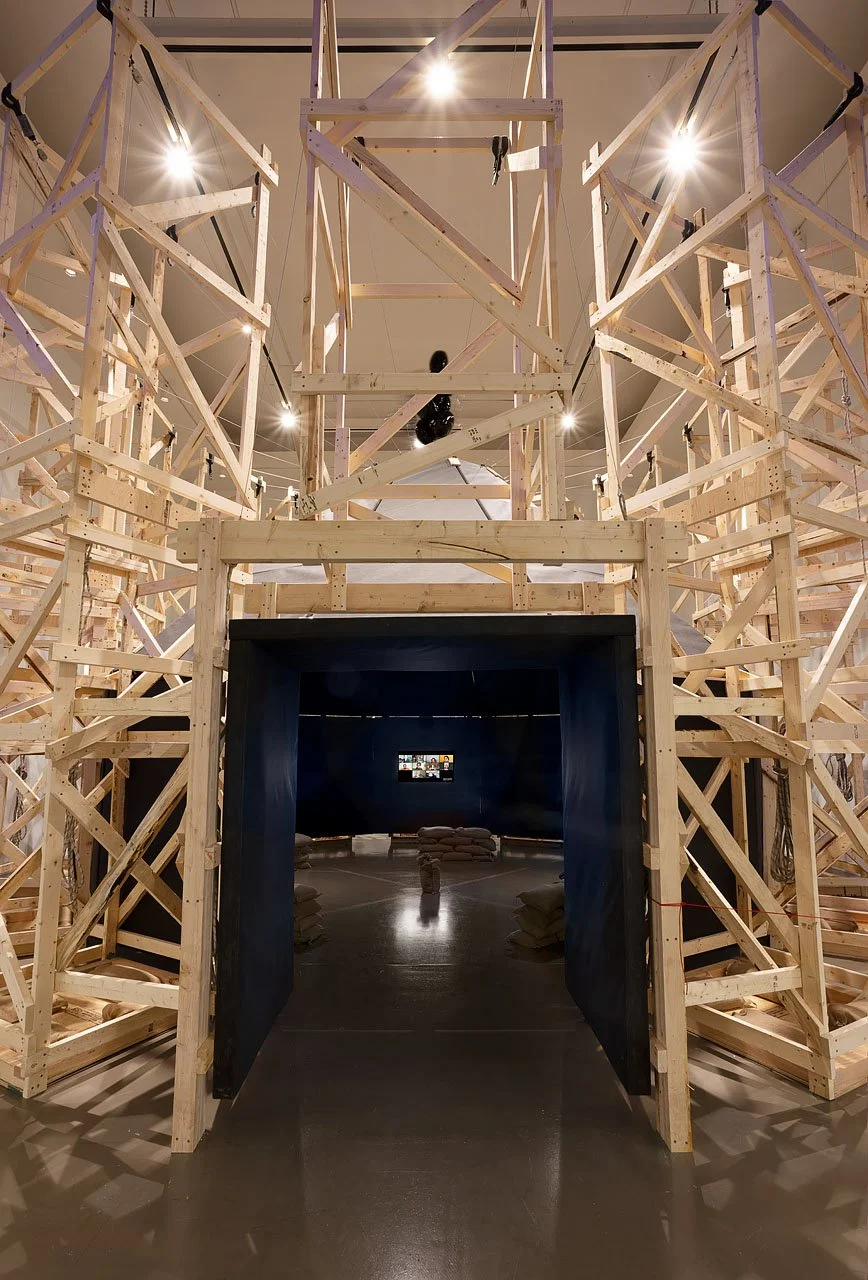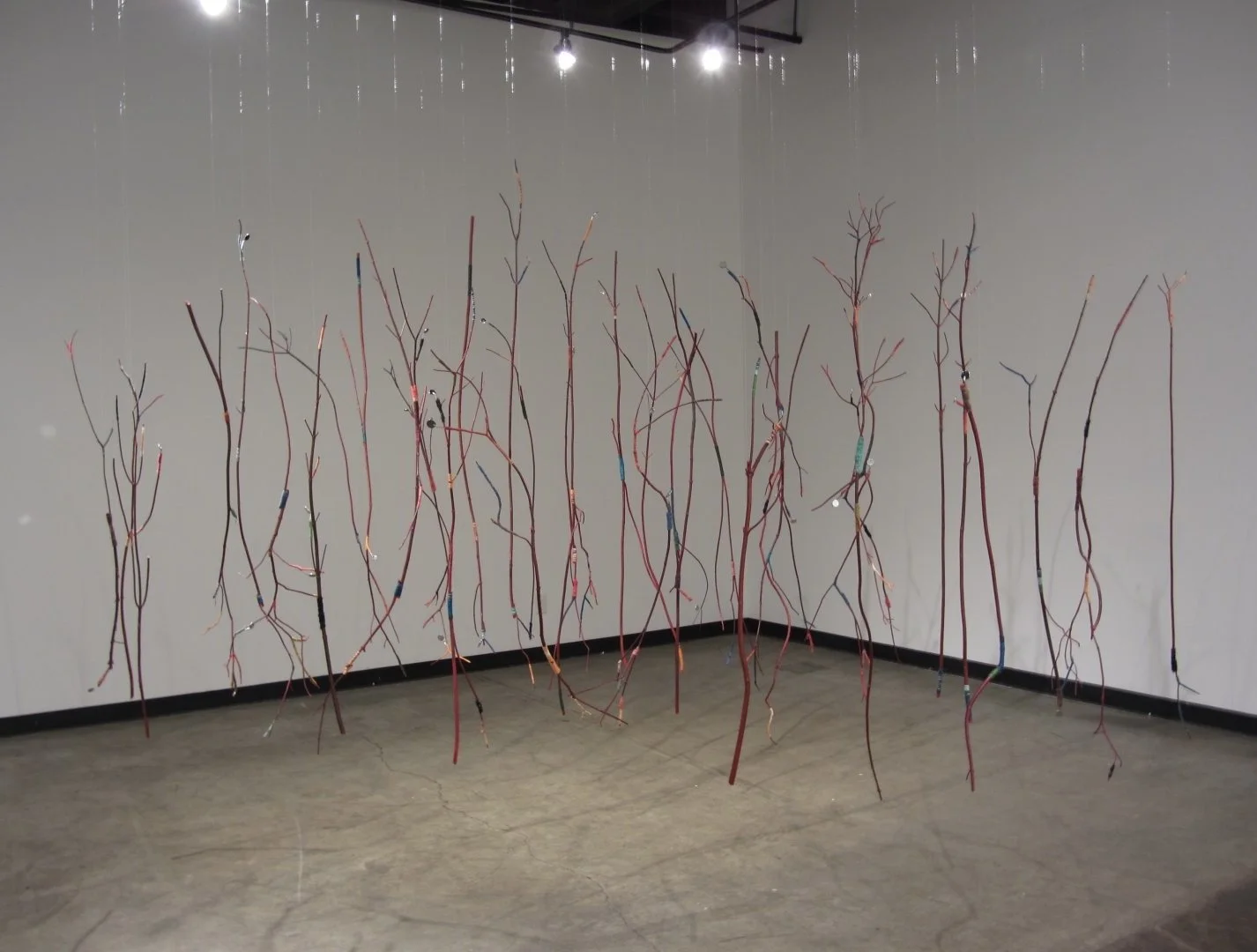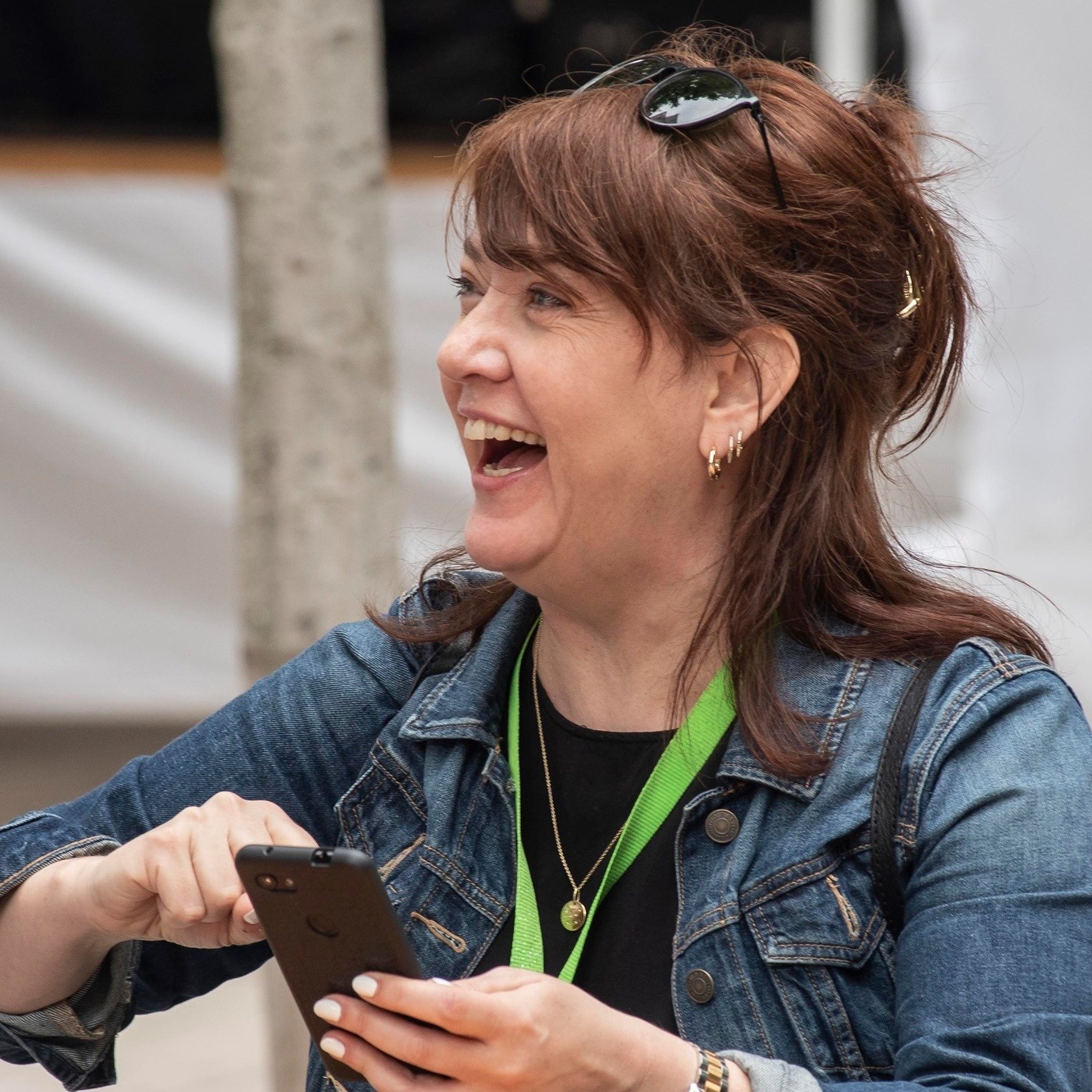At Vancouver Art Gallery, Carmen Papalia and co-conspirators explore disability justice and culture
New NEXT exhibition features an ambitious site-specific project co-created by the non-visual artist and others in social activism
Installation view of NEXT: Provisional Structures: Carmen Papalia with Co-Conspirators. Photo by Ian Lefebvre/Vancouver Art Gallery [ID: Several piles of sandbags are arranged in a circle within a rounded, darkened space. A video screen is on the back wall.]
Vancouver Art Gallery presents NEXT: Provisional Structures: Carmen Papalia with Co-Conspirators to April 16, 2023
NOW ON DISPLAY at Vancouver Art Gallery is Provisional Structure 2, a large-scale architectural installation and gathering space. Towering wooden support structures surround a modular tentlike form constructed from custom-made acoustic panels covered in black fabric. Step inside, and you’re in a darkened area where sound is the primary mode of perception; it’s a reference to the way Carmen Papalia, a local non-visual social-practice artist, privileges non-visual senses in his own life.
One element of NEXT: Provisional Structures: Carmen Papalia with Co-Conspirators now running at Vancouver Art Gallery, Provisional Structure 2 was inspired by a March 2021 online protest known as the Disability Filibuster. Papalia was one of several presenters at the event, organized by Catherine Frazee, an educator and activist who currently lives in Nova Scotia, and Gabrielle Peters, a disabled writer and policy analyst based in British Columbia.
The movement challenged the passing of Bill C-7, which expanded eligibility for medical assistance in dying (MAiD) to include people living with disabilities who are not at an end-of-life stage. Given that so many disabled people routinely encounter barriers to care, some community members are troubled by the amendment and see the policy as a form of cultural eugenics. For Papalia and others, the Disability Filibuster was a galvanizing moment within the contemporary disability movement, with people from across the country gathering to share their concerns regarding the potential harms of Bill C-7 while discussing cultures and histories of disability in Canada more broadly.
In total, the Disability Filibuster ran live, continuous broadcasts for almost 60 hours with only brief nightly breaks. Content ranged from lectures, interviews, and panel presentations to artistic, comedic, and dramatic performances to laid-back coffeehouse-style late-night conversations. Each contribution was thematically tied to the filibuster’s central mission of stopping the passage of the legislation. Inside Provisional Structures 2—by Papalia and architect Michael Lis—material from the filibuster is being continuously presented, and there are sandbags for comfortable seating and blankets to keep warm. Suspension cables run from the wood scaffolds to an oculus in the roof of the tented room, suggesting that the structure has simply been dropped into place and can consequently be easily pulled up and disassembled.
“I really think the work in the show is an example of the various ways that disability culture is a counterpoint to ableism,” Papalia said at a media tour in advance of the exhibition’s launch. “This is a concept that is ingrained in our culture and is one that we can’t and don't often recognize or understand. So I hope that this show deepens one’s understanding—whether they have a disability experience or not—of what disability culture is and the various ways that our communities are trying to preserve it and honour it, with the futures that we want to live, our present realities, and our histories as well.”
Papalia lives with a chronic and episodic pain condition that also informs his approach to the topic of accessibility. He has spent a lot of time in hospital since childhood, his experiences influencing the way he approaches institutions like museums and educational centres.
“During the filibuster, my routine was I would be laying on my heating pad under a weighted blanket while I listened to it, and it was really about just being with others in my community; it was just a very this deep sense of connection and what's really important about the filibuster I think is that,” Papalia said. “That highlighted different activist histories across the country and locally in B.C….A lot of the harm reduction kind of services and practices and drug-user activism really got highlighted during the filibuster as part of the disability-justice movement. So I thought it was a really important to bring it all in here for a few reasons, one being that one of the main instigators of the filibuster is a B.C. resident named Gabrielle Peters, who is a poor disabled woman who is a policy analyst and writer in Vancouver, and she was one of the main instigators of the filibuster. So it is also about local disability-activist histories, and it really is highlighting histories of deinstitutionalization.”
The dialogue and exchange coming out of the Disability Filibuster highlighted other issues. For instance, the idea that the opioid crisis is a disability issue is a growing conversation that in recent years has resulted in increased advocacy for safe drug supply and harm-reduction services. With this in mind, Papalia has placed six black foil balloons at the centre of the yurtlike structure to represent the number of people who die each day from overdose in British Columbia. These balloons are related to an installation of 846 balloons in the exterior windows of the Vancouver Art Gallery called Stop Fucking Killing Us. Visible on the building’s Georgia Street façade when viewed from šxʷƛ̓ ənəq Xwtl’e7énḵ Square, this mass of balloons represents the total overdose deaths anticipated in the province over the course of the exhibition.
NEXT: Provisional Structures: Carmen Papalia with Co-Conspirators is the 20th installment in NEXT: A Series of Artist Projects from the Pacific Rim. Organized by the Vancouver Art Gallery and curated by VAG associate curator Mandy Ginson in collaboration with Stephanie Bokenfohr, VAG’s adult public programs coordinator, the series highlights works previously not seen in Vancouver and seeks to engage diverse practices of regional artists.
Installation view of NEXT: Provisional Structures: Carmen Papalia with Co-Conspirators. Photo by Ian Lefebvre/Vancouver Art Gallery [ID: Tall wooden structures tower over and surround a square-shaped entrance into a dimly lit tent-like space that is mostly empty save for a few stacks of sandbags on the floor arranged in a circle and a video screen hanging on the back wall.]
Papalia, who holds a bachelor of arts degree from Simon Fraser University and a master’s of fine arts with a focus in art and social practice from Portland State University, sees museums as colonial enterprises that are marginalizing by design. His work has been featured at The Solomon R. Guggenheim Museum, The Tate Liverpool; Harvard Art Museums, and Vancouver’s Gallery Gachet, Vancouver, among many others.
NEXT: Provisional Structures came as a response to The New Access Consortium Presents: a Collective Audit of the Vancouver Art Gallery, an unsolicited accessibility audit that Papalia co-conducted in 2015.
“In doing this audit, Carmen and his peers found that the gallery was not very accessible and not very welcoming for people with disabilities,” Ginson said at the event, noting that a community and accessibility consultant has been working with Bokenfohr on the difficult and ongoing work of trying to make the gallery a more accessible, welcoming, and engaging environment for disabled visitors. “We found that one of the best ways to really learn how an arts institution might better serve disabled artists and audiences would be to invite Carmen to do a project at the gallery….The way that Carmen has explained it, Provisional Structures 2 is not a fixed object or a fixed installation. It’s more of a concept. The title refers to the idea of a model for accessibility that is not reliant on prescribed policies or practices, but rather a model that could be more spontaneous and flexible. So he’s talked, for example, about the kind of support structures that might establish themselves seemingly overnight in communities in the wake of natural disasters as a way to point to models that could function differently and be more flexible. So you might notice sandbags as a kind of recurring theme in show, for example. And that’s a reference to those ideas of collective community support.”
Also featured in NEXT is a parachute with appliqué hung from a ceiling, called Untitled, by Papalia and Heather Kai Smith. The 2022 work emanated from the artists’ reimagining of an open and collectively managed framework for accessibility and grew out of a body of work that the two presented at Banff’s Walter Phillips Gallery in 2019. A phrase excerpted from Papalia’s 2015 Open Access manifesto is sewn onto the parachute: “Open Access is a temporary, collectively-held space.” Intended to visually stand in for interdependence and collective action, the suspended form also defines a gathering space for the many public workshops, talks, performances, and events that will unfold over the course of the exhibition. Underneath it is sandbag seating; on an adjacent wall are books, resources, fidget toys, and noise-cancelling headphones; the team worked with the Canucks Autism Network to include sensory pits.
“Open Access describes accessibility as an ongoing effort that is guided by community needs,” Papalia said. “So really it describes accessibility instead of a fixed set of policies as more of a measure of agency.”
Among the other artists featured in the exhibition are Sharona Franklin, Rebel Fayola Rose (founder of Disability Justice Dreaming), and Portland-based Curiosity Paradox duo, all access advocates. (Stay tuned for forthcoming related programming details.)
“In working with Carmen Papalia and Co-Conspirators, the Vancouver Art Gallery welcomes audiences to consider the possibilities of art as a non-visual experience,” Vancouver Art Gallery CEO and director Anthony Kiendl said. “This exhibition is an example of contemporary art as a language that exceeds the visual—it is clearly about challenging ways of thinking and ideas. At the same time, the project introduces other voices and narratives from the contemporary disability movement. This creates not only an important but vital and relevant environment for the public to experience. We are very excited to be a hub for people to gather over the coming weeks of the exhibition.”















